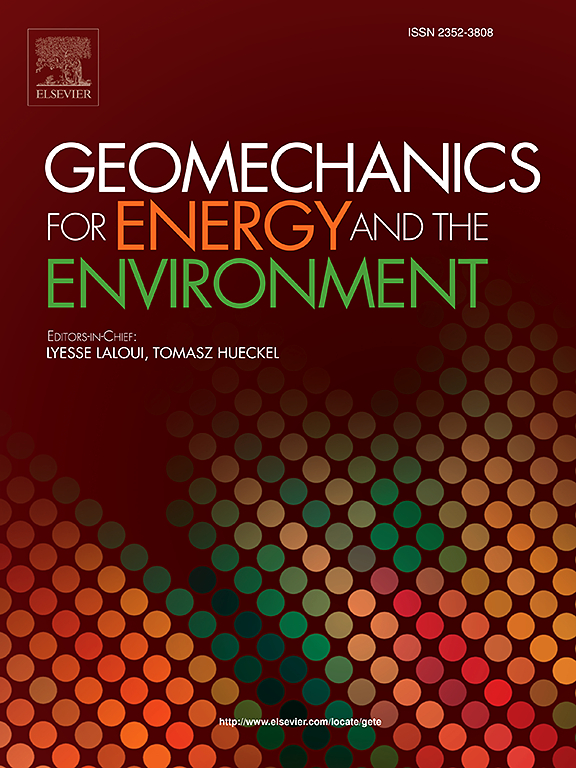Comparative tests on the failure characteristics and mechanisms of soft inclined foundation waste dump under gravity
IF 3.7
2区 工程技术
Q3 ENERGY & FUELS
引用次数: 0
Abstract
Landslide disasters occur frequently on the slopes of open-pit mine waste dumps, thus the study of their failure mechanism is crucial to mine environmental protection and safe production. This study conducted three sets of base friction model tests on waste dumps with different inclination angles. Based on an updated speckle analysis and point-tracking technology, the failure process of the waste dump slopes was obtained, focusing on analyzing the occurrence mechanism, failure mode, and stability of the slopes. The findings indicated that the waste dump slopes of inclined foundations have prominent progressive failure characteristics, and due to the influence of the inclined foundation, the waste dump slope failure mode is significantly different. According to the movement characteristics of the slopes in the tests, the deformation process of slopes was categorized into three phases: the uniform deformation phase, the local failure phase, and the overall instability phase. Taking the characteristic moment of the model entering into local failure and overall instability as the stability evaluation index, which showed that anti-inclined foundation slopes had the best stability, followed by horizontal, with down-inclined slopes being the least stable, which is basically consistent with other results. The sliding surface geometry and factor of safety of the slopes were obtained by using the strength reduction method in the FLAC3D software. The deformation characteristics of waste dump slopes with soft inclined foundations derived from numerical modeling are in basic accordance with previous base friction model test results. The study also noted that as the inclination angle of the basement changes, the sliding surface of different types of foundation waste dumps gradually changes from polyline to arc-shaped. These findings could offer qualitative insights into assessing the stability of waste dump slopes on soft inclined foundations, which are of great significance to mine environmental protection and mine safety production.
重力作用下软倾斜地基排土场破坏特征及机理对比试验
露天矿排土场边坡滑坡灾害频繁发生,研究其破坏机理对矿山环境保护和安全生产具有重要意义。本文对不同倾角的排土场进行了三组基础摩擦模型试验。基于更新的散斑分析和点跟踪技术,获得了排土场边坡的破坏过程,重点分析了边坡的发生机制、破坏模式和稳定性。研究结果表明:倾斜基础的排土场边坡具有明显的递进破坏特征,且受倾斜基础的影响,排土场边坡破坏模式存在显著差异。根据试验边坡的运动特征,将边坡的变形过程分为均匀变形阶段、局部破坏阶段和整体失稳阶段三个阶段。以模型进入局部破坏和整体失稳的特征矩为稳定性评价指标,表明抗倾斜地基边坡稳定性最好,水平边坡次之,下倾斜地基边坡稳定性最差,与其他结果基本一致。在FLAC3D软件中采用强度折减法得到边坡的滑动面几何形状和安全系数。数值模拟得出的软倾斜地基排土场边坡变形特征与前人基础摩擦模型试验结果基本一致。研究还发现,随着基底倾角的变化,不同类型的基础排土场的滑动面逐渐由多线形变为弧形。研究结果可为软倾斜基础上排土场边坡稳定性评价提供定性认识,对矿山环境保护和矿山安全生产具有重要意义。
本文章由计算机程序翻译,如有差异,请以英文原文为准。
求助全文
约1分钟内获得全文
求助全文
来源期刊

Geomechanics for Energy and the Environment
Earth and Planetary Sciences-Geotechnical Engineering and Engineering Geology
CiteScore
5.90
自引率
11.80%
发文量
87
期刊介绍:
The aim of the Journal is to publish research results of the highest quality and of lasting importance on the subject of geomechanics, with the focus on applications to geological energy production and storage, and the interaction of soils and rocks with the natural and engineered environment. Special attention is given to concepts and developments of new energy geotechnologies that comprise intrinsic mechanisms protecting the environment against a potential engineering induced damage, hence warranting sustainable usage of energy resources.
The scope of the journal is broad, including fundamental concepts in geomechanics and mechanics of porous media, the experiments and analysis of novel phenomena and applications. Of special interest are issues resulting from coupling of particular physics, chemistry and biology of external forcings, as well as of pore fluid/gas and minerals to the solid mechanics of the medium skeleton and pore fluid mechanics. The multi-scale and inter-scale interactions between the phenomena and the behavior representations are also of particular interest. Contributions to general theoretical approach to these issues, but of potential reference to geomechanics in its context of energy and the environment are also most welcome.
 求助内容:
求助内容: 应助结果提醒方式:
应助结果提醒方式:


